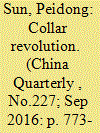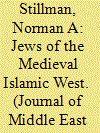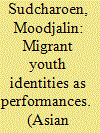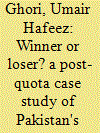| Srl | Item |
| 1 |
ID:
148772


|
|
|
|
|
| Summary/Abstract |
Scholars have paid little attention to Maoist forces and legacies, and especially to the influences of Maoism on people's everyday dress habits during the Cultural Revolution. This article proposes that people's everyday clothing during that time – a period that has often been regarded as the climax of homogenization and asceticism – became a means of resistance and expression. This article shows how during the Cultural Revolution people dressed to express resistance, whether intentionally or unintentionally, and to reflect their motivations, social class, gender and region. Drawing on oral histories collected from 65 people who experienced the Cultural Revolution and a large number of photographs taken during that period, the author aims to trace the historical source of fashion from the end of the 1970s to the 1980s in Guangdong province. In so doing, the author responds to theories of socialist state discipline, everyday cultural resistance, individualism and the nature of resistance under Mao's regime.
|
|
|
|
|
|
|
|
|
|
|
|
|
|
|
|
| 2 |
ID:
163254


|
|
|
|
|
| Summary/Abstract |
Jews constituted a significant element in the population of the medieval Muslim West, which in the Middle Ages included much of Spain as well as North Africa. They became linguistically arabized by the tenth century and adopted many elements of Islamic general culture. There were, however, limitations—both self-made and imposed by the dominant society. This article discusses the areas of contact and integration they had with Islamic culture, on the one hand, and boundaries of separation and differentiation, on the other.
|
|
|
|
|
|
|
|
|
|
|
|
|
|
|
|
| 3 |
ID:
193129


|
|
|
|
|
| Summary/Abstract |
This paper focuses on clothing policy in schools as a means to understand the Thai state’s management of diversity as well as the ways in which young migrants navigate their belongingness within the state discourse of nationalism. Because of its diverse migrant student population, a Thai state school proclaims itself a multicultural institution and instructs its students to wear ‘national clothes’ (chut pracam chat) every Tuesday. This policy enables migrant children to enter a cultural sphere where Burmese migrants are excluded, but, ironically, the very same clothes simultaneously stamp them as raeng-ngan tangdao, literally translated as ‘alien workers’. Young migrants devise strategies to downplay their alterity in public spaces and question the idea of belongingness and authenticity. Their dress practices reveal theatrical and fleeting performances of identity. But they neither fully assimilate to national standards nor assert completely distinct identities.
|
|
|
|
|
|
|
|
|
|
|
|
|
|
|
|
| 4 |
ID:
117806


|
|
|
|
|
| Publication |
2012.
|
| Summary/Abstract |
Textiles and Clothing (T&C) is a critically important sector of international trade for developing countries and least developed countries (LDCs). The T&C sector engages abundant labour resources and requires low investment threshold. The T&C sector has been a contentious area in multilateral trade negotiations. With the expiration of quotas in 2005, many T&C dependent countries are experiencing considerable adjustment challenges. Pakistan is one such country that is extensively reliant on T&C industries. This research note presents a brief case study which looks at post-quota developments in Pakistan's T&C trade and the trade and economic policy issues it raises.
|
|
|
|
|
|
|
|
|
|
|
|
|
|
|
|